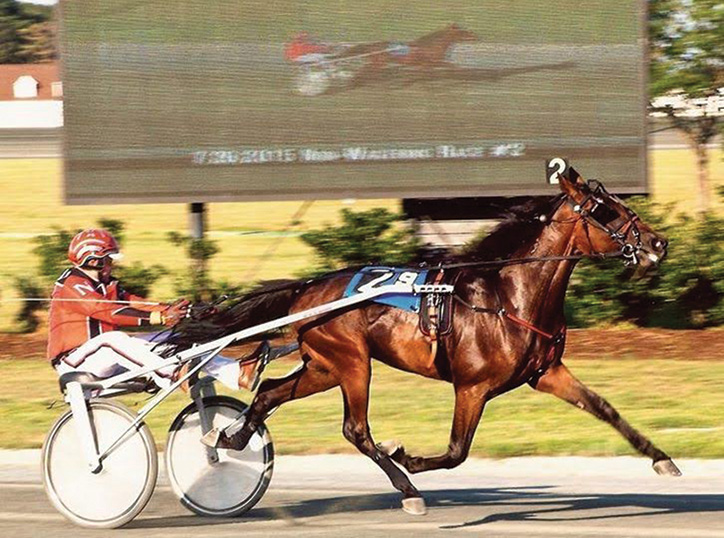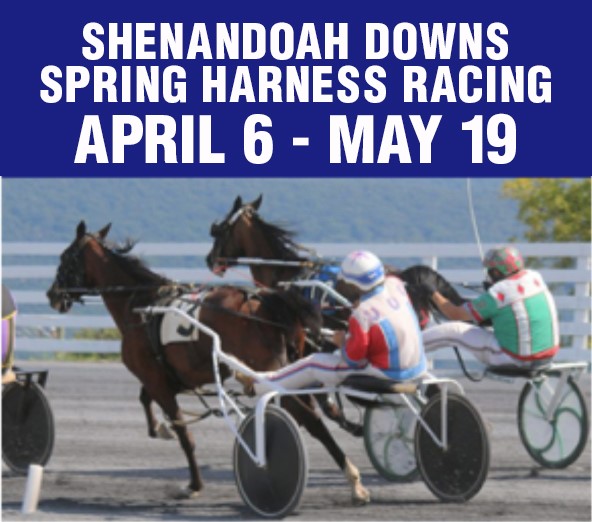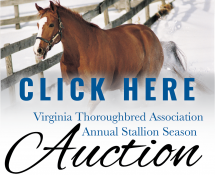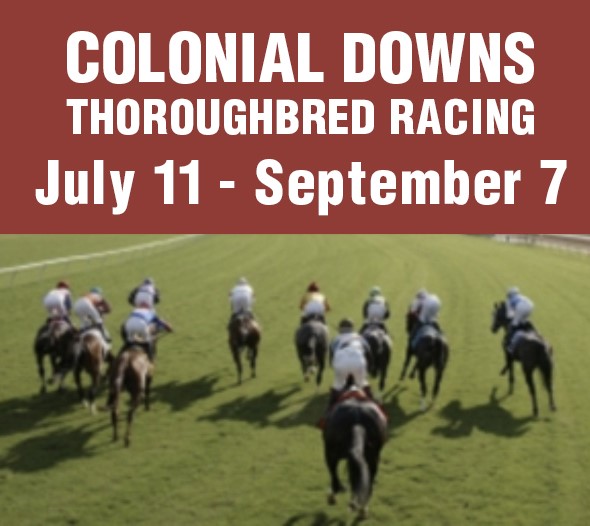The following piece appeared in the May, 2019 issue of The Rivah and was written by Lisa Hinton-Valdrighi. It focuses on several local harness racing professionals based in the Northern Neck area. Harness racing returns to Shenandoah Downs in Woodstock, Virginia September 13th and continues through October 13th.
Neal Damron’s not a professional gambler and not really a bettin’ man. But he’s definitely had a few good days at the track.
His biggest single purse was $42,000. One horse made him $67,000 in six starts.
Damron manages a logistics company by day, but his passion is his “other” job as a race horse trainer. “I was on a horse before I could walk when my dad would put me in the saddle with him,” he said.
Damron was raised in Richmond where his family was involved in the American Saddlebred show horse industry. He had a friend with a race horse and one thing led to another. In 2004, his career as a race horse trainer began.

When Damron moved to Lancaster County in 2011 to take a job at a local tech company, he was racing at New Kent County’s Colonial Downs Racetrack (that closed in 2014 but is set to reopen this spring — see related story). He was living in an apartment and renting a pasture for his horse until the apartment was destroyed by fire. That’s when he purchased a 16-acre farm near Bertrand and put in a jogging track where he’s currently training three of his horses for racing. He owns two other broodmares.
He’s trained for dozens of other owners, has been in partnership with a few other local trainers and owners and has had horses from as far as Texas sent to him for training.
A licensed trainer and driver, Damron’s speciality is harness racing, which in North America is restricted to Standardbred horses. They’re slightly heavier than a Thoroughbred, with powerful shoulders and hindquarters. They’re divided into two categories, pacers and trotters.
Damron knows several harness race trainers locally, including Scott Warnick of Middlesex, with whom he’s partnered with in the past.
“You’d be surprised about the number of people in this area associated with harness racing,” he said.
Harness racing has quite a history in the Northern Neck, where tracks were once maintained in Lively, Lancaster and at the Richmond County fairgrounds.
Training day

I caught up with Damron on a warm spring morning at the expansive Jordan Hill Farm in Lyells, near Warsaw in Richmond County, where he often takes his two-year old trotter and pacer to train. There’s a half-mile track at the farm versus Damron’s own four-tenths of a mile track. Fields of green rolled up and down a hilly landscape at the end of a winding dirt and gravel road that led to Jan Nofsinger’s farm. Nofsinger is friendly and chatty. She said she was frazzled and immediately pointed out the saying on the front of her favorite sweatshirt —I’m so busy I don’t know if I found a rope or lost my horse. She peeled the sweatshirt off to reveal a short sleeve Ocean Downs Racetrack tee-shirt. She’s also a horse trainer, bred from a long line of horse trainers. Her family owned the fair in Warsaw where harness racing took place. She had three uncles and a grandfather in the racing business.
Nofsinger’s been a licensed trainer for 20 years, but is easing out of the business. She lets others train her horses now and has one set to race at Harrington Raceway & Casino in Delaware this month. Damron initially “broke” that two-year-old filly.
Nofsinger had the horse of the year at Ocean Downs in her first year training.
She quickly apologized for her barn being unkept and dirty. It’s a barn. By definition, it’s dirty. Harnesses and tools of the trade hung along the walls.
It was a warm morning, which called for a hot water wipe down for Damron’s horses, Sidepocket Sam and Dempsey’s Darling. The warm water actually cools them off on a hot day. Think about a warm shower opening your pores and cooling you off, he said.
Taking a Standardbred out to train is not a simple, or quick, process. The horse is moved into the cross ties, which is one of the first things a trainer teaches him to do. Sam, the two-year-old trotting colt, has his hind legs wrapped then bell boots placed on his front. He’s outfitted in his harness, bits placed in his mouth and then he’s slowly moved into place at the head of the jog cart. For his female pacer, Darling, he also has to outfit her in pacing hopples. Pacers run with a lateral movement, two legs on the same side of the horse move forward together. Trotters move diagonally, which means the horse’s back left leg moves at the same time as the right front leg. Therefore, the equipment for each is different and they don’t race against each other in harness racing.
It takes about a week or more to get them used to all the equipment, said Damron.
“I get it on them in a stall and then get the hell out,” said Nofsinger.
Damron pulls out his stopwatch as he eases into the seat of the jog cart.
“A stopwatch; the number one tool you use,” he said.

He takes Sam from the barn to the track and begins a slow clockwise trot.
“When they’re babies, we don’t run them too fast,” Nofsinger explained.
It takes a pacer about eight to nine months to get them to their race time. It takes a trotter about a year.
Sam galloped slowly around the track. He was comfortable, easy, relaxed. There’s something intoxicating about the power and grace of a race horse. Tiny clouds of dirt started to rise around his feet. He was picking up the pace and after a few laps, Damron drew him to a halt and turned the cart to go counter-clockwise, which is how races are run.
“Now we’re going to really go,” said Nofsinger.
“Some will jog just as nice and when you turn them, it’s like you got a freight train. They learn, they just learn, when you make that turn, it’s time to go,” said Nofsinger.
“You’re not going to keep a race horse from racing,” she said. “It’s just like a hunting dog. He’s a hound. He’s gonna roam. A race horse has it in his blood just like that.”
Sam and Darling will jog three to four miles a day, five to six days a week. Older race horses will jog five miles.
When they are babies, their knee joints don’t close up all the way, according to Damron. So you don’t work them as hard or as long.
After Sam’s workout, he and Damron head back to the barn, where Sam sheds his harness and gear and gets a warm bath and towel dry, which is his favorite thing, said Damron.
“I’m doing good for being a baby,” Damron says rubbing Sam’s nose. The real work begins after the workout, added Nofsinger. There’s bathing, rubbing him down, checking for injuries.
“It’s like taking care of an athlete that can’t tell you what’s wrong,” said Nofsinger.
The Race
There’s mere inches between the driver and the hind legs of a horse during a race.
And Damron has had a spill or two in his over 100 races. A horse who races is totally different than a horse rode casually on trails. They are required to run at a fast pace in close quarters, surrounded by other horses and race carts.

“There’s nothing about hitting the ground at 30 miles an hour that doesn’t hurt, even with helmets and pads on,” he said.
Trainers usually take the horses to the race track for acclimation or “schooling” several times before a race to get them used to the noises, lights and other horses.
“If a horse is off in a race a tenth of a second, that can cost me thousands of dollars,” he said.
Typically, Standards start racing at two years old. He’s hoping to have his ready to race by fall.
Of course some horses just aren’t race horse material. Those that don’t make it on the race track, Damron says are often sold to the Amish.
Just like show horses or horses owned for casual Sunday afternoon trots on a nature trail, race horses are near and dear to their owners’ and trainers’ hearts. There is an obvious bond, trust and love, between Damron and his horses. It is that way for Nofsinger and her horses too.
“I don’t mind taking care of them and prepping them, but racing, oh, it’s hard. Every time they go out on that track, it’s like, just come back to me please,” she said.
Horse racing will return to Colonial Downs in August
Horse racing returns to Virginia this summer when Colonial Downs in New Kent County reopens after a nearly six-year hiatus.
Horse racing is scheduled to return to Colonial Downs in August. The last race was held in 2013 with the facility closing a year later. Revolutionary Racing bought the race track for more than $20 million last year.
For now, Virginians will be able to play slots-style machines in a casino-like setting at Rosie’s Gaming Emporium at Colonial Downs and at four other locations across the state, according to a release from the Capital News Service. The gaming emporium was set to open April 23.
The Colonial Downs Group also will open gaming parlors in Richmond, Hampton, Chesapeake and Roanoke County.
The 600 historical horse racing machines at Rosie’s will look like a slot machine but the machines use previously run horse races to determine if you win or lose, according to the release. Those playing don’t need to know a thing about the sport. Minimum bets start at 20 cents.
Thoroughbreds will return to the track in August. Local trainers like Lancaster County’s Neal Damron, who used to race at Colonial Downs, hope the track brings back harness racing, which was once a popular draw at the facility.
2019 RACE SCHEDULE
- August 8-10, 5 p.m.
- August 15-17, 5 p.m.
- August 22-24, 5 p.m.
- August 29-30, 5 p.m.
- August 31, 5 p.m.
- Virginia Oaks and Virginia Derby – September 2, 1 p.m.
- September 6-7, 5 p.m.







